Mares Colostrum Collection and Storage
By Patrick M. McCue, DVM, PhD, Diplomate American College of Theriogenologists, Colorado State University
https://www.arssales.com/colostrum_101.html
Colostrum is the thick, sticky yellow fluid produced by the mammary gland of the mare during the last few weeks of pregnancy. It is comprised of carbohydrates, fats, proteins and electrolytes. Colostrum is rich in antibodies that are critically important for immune protection of the newborn foal. The process by which foals acquire antibodies from the colostrum of their dam is called ‘passive transfer of immunity’.
The epitheliochorial-type placenta of the horse prevents in utero transfer of antibodies from the mare to the fetus. Consequently, foals are born without any antibody protection. The newborn foal is thus entirely dependent on antibodies from colostrum for protection against infection during the early neonatal period.
The mammary gland selectively concentrates antibodies (primarily IgG class and some IgM class
antibodies) from the blood of the mare during the last two to three weeks of pregnancy. The mammary gland is capable of directly producing some IgA class antibodies that are found in colostrum. The average IgG concentration in equine colostrum is approximately 7,000 mg/dl (70 g/L) and ranges from 3000 to 12,000 mg/dl (30 to 120 g/L).
Under normal circumstances, a foal will stand and nurse within 1-2 hours after it is born. Specialized enterocyte cells lining the small intestine absorb colostral antibodies by a process termed pinocytosis. The enterocytes engulf droplets of colostrum from the intestinal lumen, transfer the droplets in small vacuoles across the cell and then discharge the contents into lymphatic vessels. The lymphatics subsequently transport the antibodies to the blood stream.
The capacity of the small intestine to absorb and transfer antibodies is greatest during the first 6-8 hours after birth. It declines substantially after 12 hours and within 24 hours after birth the specialized intestinal cells are replaced by cells incapable of transferring antibodies. Consequently, ingestion of colostrum by the foal after 24 hours of age will not result in an increase in blood antibody levels.
Foals need to ingest approximately two to three liters of good quality colostrum within the first few hours of life to acquire sufficient antibodies to protect against infectious diseases.
Mares produce colostrum only once in the course of a pregnancy. Colostrum is rapidly depleted as the foal nurses throughout the first day of life. Within 24 hours after foaling, the mammary gland no longer contains colostrum and the milk produced thereafter does not contain high concentrations of antibodies.
Mares that leak colostrum prior to foaling can also lose a majority of the antibody rich fluid before the foal can have a chance to nurse. Consequently, the foal may not ingest and absorb sufficient antibodies to gain immune protection from microorganisms in the environment.
Evaluation of Colostrum Quality
Evaluation of mare colostrum immediately after foaling and prior to nursing can be helpful in predicting if failure of passive transfer is likely to occur. This is especially true in situations in which colostrum has been lost due to premature leakage from the mammary gland, or if the colostrum quality is poor. Evaluation of colostrum is also valuable in determining the quality of colostrum to be harvested and stored in a colostrum bank.
Quantitative measurement of IgG levels in colostrum can be obtained by a radial immunodiffusion (RID) assay. Unfortunately, the RID technique is not a test that can be performed easily on a farm and takes approximately 24 hours to obtain results. Qualitative assessment of colostrum can be performed using a Brix refractometer to evaluate optical density or a colostrometer to determine specific gravity. Specific gravity and optical density are correlated with antibody (IgG) content of colostrum.
Equine Colostrum Refractometer (Brix)
ARS Equine Colostrum Refractometer
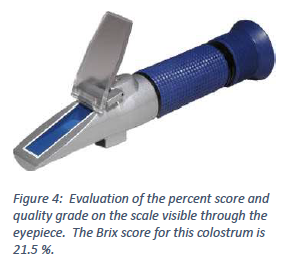 Refractometry measures the concentration of dissolved solids in a solution. To evaluate colostrum using the equine colostrum refractometer, a small amount of colostrum is collected (Figure 1), and one to two drops are placed on the prism (Figures 2 and 3) and the daylight plate is closed. Closure of the daylight plate spreads the colostrum evenly across the prism. The refractometer is held in the direction of a light source and the deviation or refraction of light is evaluated on a scale as a percentage score (Figure 4). The level or location of the color (blue) on the scale is determined. The scale contains graduations (%) and a quality assessment score for accurate interpretation.
Refractometry measures the concentration of dissolved solids in a solution. To evaluate colostrum using the equine colostrum refractometer, a small amount of colostrum is collected (Figure 1), and one to two drops are placed on the prism (Figures 2 and 3) and the daylight plate is closed. Closure of the daylight plate spreads the colostrum evenly across the prism. The refractometer is held in the direction of a light source and the deviation or refraction of light is evaluated on a scale as a percentage score (Figure 4). The level or location of the color (blue) on the scale is determined. The scale contains graduations (%) and a quality assessment score for accurate interpretation.
Colostrum with a low amount of dissolved solids (i.e. low IgG level) will have a lower amount of light scatter and a lower percentage score. Colostrum with high amounts of dissolved solids (i.e. high IgG levels) will cause more light scatter and therefore have a higher percentage score. Refractometer evaluation of equine colostrum has been shown to be highly repeatable and highly correlated with IgG levels as measured by the radial immunodiffusion assay.
Specific Gravity
The specific gravity or density of equine colostrum can be determined by use of a colostrometer. Colostrum with high IgG levels has a greater density and therefore a higher specific gravity. A volume of exactly 15 mls is added to the glass chamber. The colostrum-filled chamber is then placed in a graduated cylinder containing distilled water and allowed to float. The specific gravity of the colostrum is measured by reading the scale on the glass cylinder. Colostrum with a specific gravity level of < 1.06 is considered poor. Colostrum with a specific gravity of > 1.08 is considered very good. Determination of the specific gravity of equine colostrum is dependent on accurate measurement of an exact volume (15 mls) of colostrum. Small errors in volume measurement lead to inaccuracy of specific gravity determination.
Interpretation and Colostrum Management
The relationship between refractometry percentage, specific gravity and overall colostrum quality assessment is presented in the table below:
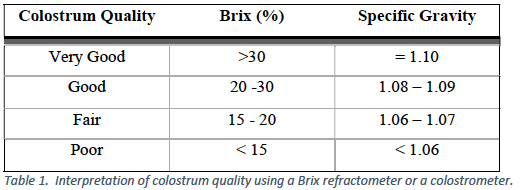
Successful passive transfer of antibodies from the mare to her foal depends on many factors, including quality and quantity of colostrum, timing of the ingestion of colostrum, health status of the foal, and absorption of antibodies by the small intestine.
Assessment of colostrum quality evaluates only one component of the passive transfer process. However, if it can be determined that the quality of the colostrum produced by a mare is inadequate, the foal can be supplemented with additional frozen-thawed colostrum of good quality or with an oral colostrum substitute containing equine antibodies.
Colostrum Bank
An owner or farm manager generally does not know in advance which foal will need supplemental colostrum. An on-site supply of frozen colostrum can be critical for the health of a valuable neonate.
The best colostrum donors are mares that have had one or more foals and are 4-15 years of age. Vaccination 4 to 6 weeks prior to foaling will increase antibody content of colostrum and consequently increase the quality of colostrum to be collected for storage. Colostrum volume and quality are not as good from young maiden mares or older mares. Mares that have dripped milk for several hours prior to foaling may not have a large volume of good quality colostrum remaining in their udder and may not make suitable donors for a colostrum bank. Colostrum should not be saved from a mare with a history of having a foal affected by neonatal isoerythrolysis (NI or Jaundice Foal Syndrome) or that died from unknown causes within the first few days after birth.
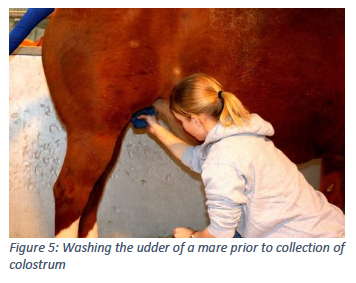 Good quality colostrum is thick, yellow in color and sticky in texture. Poor quality colostrum is often watery, white in color and non-viscous in texture. Good colostrum has a Brix score of ³ 23 % and a specific gravity of > 1.06. Prior to banking colostrum, a blood test for the presence of anti-RBC antibodies should be taken from your mare. The testing is to prevent the
Good quality colostrum is thick, yellow in color and sticky in texture. Poor quality colostrum is often watery, white in color and non-viscous in texture. Good colostrum has a Brix score of ³ 23 % and a specific gravity of > 1.06. Prior to banking colostrum, a blood test for the presence of anti-RBC antibodies should be taken from your mare. The testing is to prevent the
possibility of inducing NI (neonatal isoerythrolysis) in a foal receiving the stored. A blood test can be submitted two weeks prior to your mare foaling by your veterinarian.
UC Davis Veterinary Medicine Submission Form
Harvesting Colostrum
 The technique for harvesting colostrum for banking is relatively simple. The udder of the mare should be washed with warm water and soap to remove debris and bacteria (Figure 5). It is recommended that colostrum be collected from one side of the mammary gland from a donor mare in the first hour after foaling before her foal has nursed. A total of 8 to 16 oz may be safely harvested from the mare without adversely affecting the ability of the newborn foal to acquire sufficient colostrum for adequate passive transfer of antibodies. Options for collecting colostrum include hand milking, using an inverted syringe, or using a commercial milking device. Stripping or milking colostrum by hand directly into a clean glass or plastic measuring cup 16 to 32 oz in capacity will make it easy to evaluate the volume that has been collected (Figure 6).
The technique for harvesting colostrum for banking is relatively simple. The udder of the mare should be washed with warm water and soap to remove debris and bacteria (Figure 5). It is recommended that colostrum be collected from one side of the mammary gland from a donor mare in the first hour after foaling before her foal has nursed. A total of 8 to 16 oz may be safely harvested from the mare without adversely affecting the ability of the newborn foal to acquire sufficient colostrum for adequate passive transfer of antibodies. Options for collecting colostrum include hand milking, using an inverted syringe, or using a commercial milking device. Stripping or milking colostrum by hand directly into a clean glass or plastic measuring cup 16 to 32 oz in capacity will make it easy to evaluate the volume that has been collected (Figure 6).
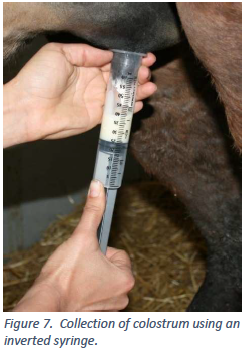 Alternatively, colostrum can be harvested using an inverted 60 ml syringe as a simple milking device. To make the unit, cut the tip off of a 60 ml plastic syringe. Reverse the syringe plunger (i.e. insert the plunger into the end the tip was removed from) and place the flared end of the syringe over the mare’s teat snug against the udder. A gentle pull on the plunger will create suction and draw colostrum down into the syringe (Figure 7). The colostrum in the syringe is then transferred into a larger measuring cup and the process repeated until the desired volume is obtained.
Alternatively, colostrum can be harvested using an inverted 60 ml syringe as a simple milking device. To make the unit, cut the tip off of a 60 ml plastic syringe. Reverse the syringe plunger (i.e. insert the plunger into the end the tip was removed from) and place the flared end of the syringe over the mare’s teat snug against the udder. A gentle pull on the plunger will create suction and draw colostrum down into the syringe (Figure 7). The colostrum in the syringe is then transferred into a larger measuring cup and the process repeated until the desired volume is obtained.
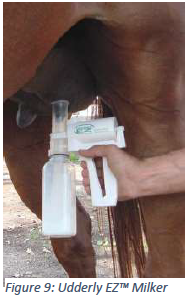 Udderly EZ™ Milker by EZ Animal Products, LLC makes a product that makes harvesting colostrum an easy task. A hand-held trigger operated vacuum pump used for the extraction of colostrum, the milking out of mares and other species that have mastitis, or for milking mares whose foals have inherited a different blood type than that of the mare and are at risk for NI (neonatal isoerythrolysis). Just a few pulls on the trigger, creates a vacuum in the bottle and the colostrum or milk flow starts—filling the bottle (Figure 8).
Udderly EZ™ Milker by EZ Animal Products, LLC makes a product that makes harvesting colostrum an easy task. A hand-held trigger operated vacuum pump used for the extraction of colostrum, the milking out of mares and other species that have mastitis, or for milking mares whose foals have inherited a different blood type than that of the mare and are at risk for NI (neonatal isoerythrolysis). Just a few pulls on the trigger, creates a vacuum in the bottle and the colostrum or milk flow starts—filling the bottle (Figure 8).
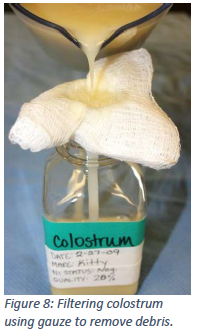 Harvested colostrum should be passed through a gauze filter or new cheesecloth into a storage container (Figure 9). Colostrum should be stored in 8 to 16 oz plastic bottles labeled with the donor mare’s name, collection date and colostrum quality. Glass bottles or plastic freezer bags are not recommended for storage of frozen colostrum. Frozen equine colostrum can be safely stored for 1-2 years in a standard -20◦ C freezer. Colostrum should be harvested each breeding season to replenish the colostrum bank with a fresh supply.
Harvested colostrum should be passed through a gauze filter or new cheesecloth into a storage container (Figure 9). Colostrum should be stored in 8 to 16 oz plastic bottles labeled with the donor mare’s name, collection date and colostrum quality. Glass bottles or plastic freezer bags are not recommended for storage of frozen colostrum. Frozen equine colostrum can be safely stored for 1-2 years in a standard -20◦ C freezer. Colostrum should be harvested each breeding season to replenish the colostrum bank with a fresh supply.
Thawing Colostrum
Frozen colostrum should be thawed in a water bath at room temperature. Thawing in hot water or in a microwave will destroy the antibodies and render the colostrum useless. It is recommended that colostrum be administered immediately after thawing.
Related Products in this article can be purchased online at ARS Sales
Equine Colostrum Refractometer
Udderly EZ™ Milker
(The safest and most effective milk and colostrum collection device available.)
Udderly EZ™ Colostrum Collection/Storage Bottles
 Your new foal has arrived! You are full of joy and overwhelmed with excitement. However, your job is not done. Over the next 24 hours after birth, it is important to continue to observe the mare and foal closely. Look for the following, and pay special attention to nursing:
Your new foal has arrived! You are full of joy and overwhelmed with excitement. However, your job is not done. Over the next 24 hours after birth, it is important to continue to observe the mare and foal closely. Look for the following, and pay special attention to nursing:
The foal should be breathing normally.
The foal should be bright and alert to its new surroundings. The foal should make attempts to rise within 30 minutes following its birth.
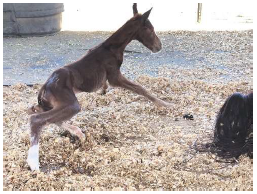 Within two hours of birth, the foal should stand and nurse. If the foal has not nursed within four hours, call your veterinarian. The foal may be weak and in need of assistance or medical attention. (See more about the importance of nursing and colostrum below.)
Within two hours of birth, the foal should stand and nurse. If the foal has not nursed within four hours, call your veterinarian. The foal may be weak and in need of assistance or medical attention. (See more about the importance of nursing and colostrum below.)
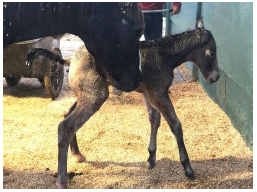 The foal should pass meconium (the first sticky, dark stool) within 12 hours after birth. If not, an enema may be needed. We recommend using an Enema (standard adult size) after birth to help ensure the passing of meconium and lesson the changes of problems. Female foals do not urinate until about 11 hours after birth; male foals may take six hours to urinate after foaling.
The foal should pass meconium (the first sticky, dark stool) within 12 hours after birth. If not, an enema may be needed. We recommend using an Enema (standard adult size) after birth to help ensure the passing of meconium and lesson the changes of problems. Female foals do not urinate until about 11 hours after birth; male foals may take six hours to urinate after foaling.
Many foals begin life with weak legs. Do not be overly concerned if the baby is down in the pasterns and fetlocks for the first day or two of life. They will generally straighten up. However, if you see extreme deviations of limbs or note other physical problems, or the condition persists, consult your veterinarian.
The mare should be non-aggressive, curious, and accepting of her newborn. Occasionally a mare will reject her foal. Foal rejection is more common in maiden mares. In such a case, the mare can be aggressive, kicking and biting. The foal should be removed and reintroduced with the mare under restraint and or sedation given by your veterinarian.
The mare should be bright and alert. Allow her to eat as soon as she is ready and supply plenty of clean, fresh water. You may wish to check the mare’s temperature and other vital signs periodically within the first 24 hours to make sure they are normal. An elevated temperature may indicate infection (normal range is 99.5 to 101.5 F).
The Importance of Colostrum
It is essential that the foal receive an adequate supply of colostrum. Colostrum, the mare’s first milk, which is extremely rich in antibodies. It provides the foal with passive immunity to help prevent disease until its own immune system kicks in.
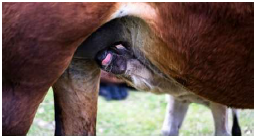 A foal must receive colostrum within the first eight to 12 hours of life in order to absorb the antibodies. If a foal is too weak to nurse, it may be necessary to milk the mare and give the colostrum to the foal via a stomach tube, contact your veterinarian. If a mare appears to be leaking milk prior to birth, consult your veterinarian. For orphan foals, or mares without an adequate supply of colostrum, it is important to locate a backup supply. Without it, the foal is at an increased risk of infections. Consult your veterinarian.
A foal must receive colostrum within the first eight to 12 hours of life in order to absorb the antibodies. If a foal is too weak to nurse, it may be necessary to milk the mare and give the colostrum to the foal via a stomach tube, contact your veterinarian. If a mare appears to be leaking milk prior to birth, consult your veterinarian. For orphan foals, or mares without an adequate supply of colostrum, it is important to locate a backup supply. Without it, the foal is at an increased risk of infections. Consult your veterinarian.
Your veterinarian can test the colostrum to determine whether it is rich in antibodies. Doing a blood test on the foal at 18 to 24 hours of age to evaluate IgG antibody levels will determine if the foal received adequate levels of rich colostrum. Most of the absorption (85 percent) takes place within the first six to eight hours. The foal can be tested when it is twelve hours old, and if IgG is deficient, it can be supplemented. If you wait until the foal is 24 hours old to evaluate IgG absorption and it proves to be inadequate, your only option will be a plasma transfusion. If IgG is inadequate, treatment for Failure of Passive Transfer (FPT) should be instituted by your veterinarian.

When to Call the Vet
If you notice any problems in the first 24 hours after birth, especially issues with nursing within the first 4 hours, call your veterinarian. It is better to have the foal or mare checked early, before any possible issues become complicated. Bandalero Ranch Equine Veterinary offers a full range of reproductive, foaling, and postpartum care services. Call us at 520-760-6200.
Prior to foaling it is important to screen the mare for Neonatal Isoerythrolysis (NI), also known as “Jaundice Foal Disease”. An “NI Positive” mare is one that will produce antibodies in her colostrum that will attack the foal’s red blood cells once the foal has absorbed the antibodies. These antibodies were formed by the mare in response to exposure to a blood type different from her own. This can occur when there is leakage of foal’s blood from the placenta, usually during foaling, when a previous foal had a blood type the same as the stallion and not the mare. Because of this, mares that have had more than one foal are more likely to be at risk for being “NI Positive”, but it is also possible for a maiden mare, or first time foaling mare, to have formed antibodies against different blood types. This could have occurred if she had any type of blood contamination (e.g. blood transfusion, or IV injections with needles reused among different horses) earlier in life. A foal that nurses this “taunted” colostrum will be fine at first and then around 24 to 48 hours of life start getting weak. This weakness is a result of the lytic anemia as the foal’s newly acquired antibodies start destroying its own red blood cells. As the destroyed red blood cells start building up, the foal’s gums, sclera, and sometimes skin will take on a yellow or jaundiced look, thus where the name “Jaundice Foal Disease” comes from. A foal affected with this disease will require intensive veterinary care including, fluid and nutritional support, anti-inflammatories, and often blood transfusions. Even with medical care the prognosis is often poor to grave (i.e. the foal dies regardless) and it is much easier (and cheaper) to prevent the disease than try to treat it.
The NI Screen is easily performed by drawing blood from the mare into a red top tube at about 2-3 weeks prior to the mares due date, and/or after significant udder development. The blood is submitted to a veterinary lab where it is checked for any antibody reactivity against different blood types. If the mare is deemed “Positive” it is necessary to monitor the mare closely and when she foals, supplement the foal with frozen-thawed NI negative colostrum from a different mare source as well as keep the foal muzzled so it cannot nurse from its dame until all of her bad colostrum has been stripped from her udder. An average sized foal will need about 2 pints of NI Negative colostrum total in the first 12 hours of life. It is a good idea to discuss a plan with your veterinarian if you mare is tested “NI Positive” so that everything goes smoothly when the mare decides to foal at 3AM.
Newborn foals can be exciting, fun, and enjoyable. You may have a beautiful mare you have competed on, worked cattle with, or personal riding horse and you want another one like her. There are plenty of motivations for breeding a mare. Make no mistake, though, there are many factors to consider before diving into the breeding process.
Does breeding your mare make sense? Determine if the mare is a good breeding candidate. Some major considerations are physical conformation, disposition, and age. While no horse is perfect, you should consider all your mare’s faults and weaknesses. This will also help you when choosing the right stallion. Do your research and choose a stallion that will not double up on your mare’s faults and weaknesses.
Stud fees can range from $250 to over $25,000. Investing in the best stallion genetics that is realistic for your budget is necessary. If planning to cut corners with the stud fee, rethink if breeding your mare is the right choice. To quote a thoroughbred breeders’ mantra, “Breed the best you have with the best that you can afford.” Regardless of whether you choose artificial insemination (AI) with “cooled shipped semen”, “frozen semen” or “live cover,” you will be responsible for a booking fee (ranging from $100- $800) to reserve your spot in line for the stallion’s services in the upcoming breeding season. Read your contracts thoroughly. If “frozen semen” is the only option for breeding to the stallion you have chosen make sure you ask your veterinarian if they are proficient in breeding with frozen semen before you sign and pay for the contract.
 Veterinarian costs for breeding your mare will become THE TRUE COST FOR YOU. There is no use in breeding mares with poor conformation and a bad attitude — you’ll get more horses with poor confirmation and a bad attitude. Also, breeding maiden (never been pregnant) mares, can be more expensive with failure to conceive. Have you considered the long-term commitment of breeding and having a foal to feed for years to come? Are you planning on selling the foal after it is weaned? Do you have the time to halter train the foal and/or train it to ride?
Veterinarian costs for breeding your mare will become THE TRUE COST FOR YOU. There is no use in breeding mares with poor conformation and a bad attitude — you’ll get more horses with poor confirmation and a bad attitude. Also, breeding maiden (never been pregnant) mares, can be more expensive with failure to conceive. Have you considered the long-term commitment of breeding and having a foal to feed for years to come? Are you planning on selling the foal after it is weaned? Do you have the time to halter train the foal and/or train it to ride?
If you will have extra money to care for the mare and foal, any potential post foaling complications and the ability to commit the necessary time for the next several years then it’s time to consider the cost of breeding your mare. The one-time stud fee for the stallion you have chosen is the first part. Breeding your mare until it has a positive pregnancy and heartbeat costs vary. Here is a list of other costs to consider, prices will vary depending on your location and veterinarian.
- Prior to breeding your mare, she must be current on all vaccines as your mare will not be vaccinated again until 10 months of gestation. ($50-$100)
- It is recommended that your mare has a Pre-Breeding ultrasound. For mares who have never been bred, doing so will provide you with the necessary information about their reproductive tract and tell you if they are a good candidate for breeding. We recommend doing this prior to buying your stud fee.
- An experienced reproductive veterinarian will monitor your mares’ cycle closely to determine follicle size and timing of breeding to stallion. When the mare follicle size is getting closer to breeding and ultrasound daily is to be expected. ($50 – $100 per ultrasound)
 Shipped Cooled Semen is sent via Fed-Ex and/or counter to counter via airline carrier. The cost of transporting the semen is your responsibility and the stallion owner/station will charge you for this. Most veterinarians try to use Fed-Ex shipping due to the ease delivery of package to their office and the lower cost to the client. However, if your mare changes quickly and there is fear the semen won’t arrive before ovulation than counter to counter via airline carrier is necessary. (Collection with Fed-Ex Shipping $300+, Collection with Airline Shipping $400+) These fees are just guidelines. All fees are generally written in you stallion breeding contract. If they are not listed, ask before you sign.
Shipped Cooled Semen is sent via Fed-Ex and/or counter to counter via airline carrier. The cost of transporting the semen is your responsibility and the stallion owner/station will charge you for this. Most veterinarians try to use Fed-Ex shipping due to the ease delivery of package to their office and the lower cost to the client. However, if your mare changes quickly and there is fear the semen won’t arrive before ovulation than counter to counter via airline carrier is necessary. (Collection with Fed-Ex Shipping $300+, Collection with Airline Shipping $400+) These fees are just guidelines. All fees are generally written in you stallion breeding contract. If they are not listed, ask before you sign.- Alternatively, frozen semen is an option. Ask your veterinarian if they can breed your mare with frozen semen and to explain how the process differs. The cost of breeding with frozen semen are much higher due to the labor-intensive process for the veterinarian.
If your mare does not become pregnant after the first cycle, it does not necessarily mean there is a problem unless there is specific evidence to support it. However, if a mare does not become pregnant after two or three cycles, it is important to consider all factors as to why she is not getting bred.
- Prior to insemination, your mare must be current on all vaccinations ($0-$50), and it is recommended she have a reproductive tract exam and uterine culture done to confirm health (~$200).
- A good reproductive veterinarian will need to closely monitor your mare’s ovarian cycle via ultrasound ($50-$100 per visit) for a number of days prior to AI. This is necessary to determine when to have the semen collected ($100-$150), shipped overnight ($75-$200 depending on destination), and plan the most effective time to inseminate ($95+).
- Are willing to pay board (roughly $18 to $25 per day for up to two weeks depending on how quickly she ovulates).
- Any hormones used in the process of getting your mare to cycle should be considered ($100-$150).
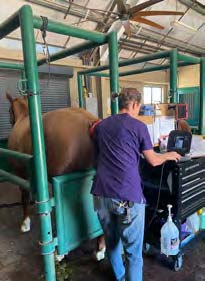 At least one to two visits to the vet, post breeding at 14 days to confirm pregnancy and one at 30 days to confirm via ultrasound a heartbeat and successful ongoing pregnancy ($50 – $100 per visit).
At least one to two visits to the vet, post breeding at 14 days to confirm pregnancy and one at 30 days to confirm via ultrasound a heartbeat and successful ongoing pregnancy ($50 – $100 per visit).- If your mare does not become pregnant after the first cycle, can you spend the money to try again? It does not necessarily mean there is a problem unless there is specific evidence to support it. However, if a mare does not become pregnant after two or three cycles, it is important to consider all factors as to why she is not getting bred and decide if you are willing to pay for cultures ($200+) to determine if your mare has an underlining uterine infection.
 Your mare is confirmed pregnant at 14 days and a heartbeat is confirmed at 30. Generally, after the heartbeat ultrasound exam veterinarians will not see you again until months 5, 7, and 9, when it is strongly recommended that the mare receive a dose of a Pneumobort HSV-1 booster vaccine. This vaccine boosts the mare’s immune system and helps prevent rhinoneumonitis, which can lead to abortion.
Your mare is confirmed pregnant at 14 days and a heartbeat is confirmed at 30. Generally, after the heartbeat ultrasound exam veterinarians will not see you again until months 5, 7, and 9, when it is strongly recommended that the mare receive a dose of a Pneumobort HSV-1 booster vaccine. This vaccine boosts the mare’s immune system and helps prevent rhinoneumonitis, which can lead to abortion.
 If all goes according to plan, in approximately 340 days (11 months) the new foal will be born. Following delivery, your veterinarian should perform a wellness exam on the mare and the foal. Even if both appear healthy, it is important to confirm the mare was able to pass the placenta, the foal is adequately nursing and has received the necessary colostrum to thrive. (IgG blood test $50). The exam will also ensure the foal doesn’t show any signs of limb abnormalities or infections. Another relatively common and potentially life-threatening complication following parturition is “broodmare colic.” With the uterine contractions and sudden internal absence of the foal, torsion of the mare’s colon and intestine is possible. Monitor mares for colic symptoms following foaling. Any of these complications have the potential to significantly increase the costs of your breeding venture. Besides the foaling process, there are a few additional costs to consider.
If all goes according to plan, in approximately 340 days (11 months) the new foal will be born. Following delivery, your veterinarian should perform a wellness exam on the mare and the foal. Even if both appear healthy, it is important to confirm the mare was able to pass the placenta, the foal is adequately nursing and has received the necessary colostrum to thrive. (IgG blood test $50). The exam will also ensure the foal doesn’t show any signs of limb abnormalities or infections. Another relatively common and potentially life-threatening complication following parturition is “broodmare colic.” With the uterine contractions and sudden internal absence of the foal, torsion of the mare’s colon and intestine is possible. Monitor mares for colic symptoms following foaling. Any of these complications have the potential to significantly increase the costs of your breeding venture. Besides the foaling process, there are a few additional costs to consider.
If the foal is a colt, he will probably be gelded, ideally within the first year of his life ($300). It is also a common practice to vaccinate the foal at 3 months of age ($100 for miscellaneous vaccines). If you plan to register the foal with a breed association such as the American Quarter Horse Association, those costs should be included as well ($50-$150).
The Bottom Line… having a mare bred requires serious investment of money, time, and mental toughness. If considering breeding your mare, make the responsible decision of whether your mare is a suitable candidate and if you have the disposable income and time to do it right. On the other hand, if you believe your mare is a good breeding candidate and you are prepared for the challenge, then we truly wish you luck, enjoyment, and success!
By: Dr. Alicia Lindholm



